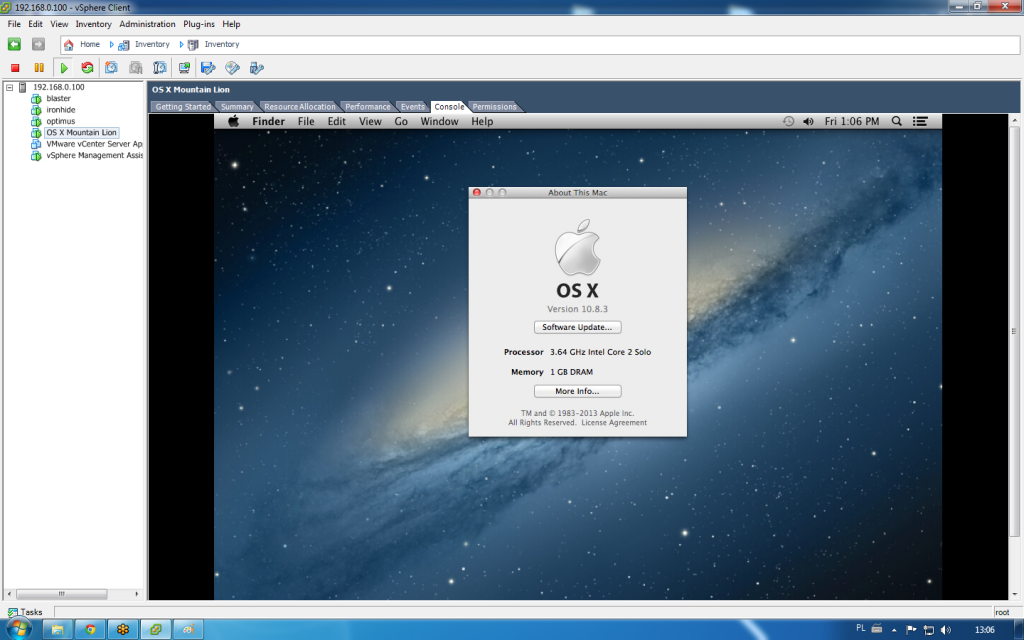Dokonała się rewolucja w domowym sprzęcie, serwer już nie działa na unraidzie z jego wywalającymi się pluginami, tylko jest hostem darmowego vmware esxi 5.5.
Pokłosiem tych zmian będzie pewnie parę notek o linuksiarstwie i rozwiązywaniu problemów.
Jednym z problemów był shutdown serwera a wcześniej bezpieczne zamknięcie maszyn wirtualnych – po co narażać domowe archiwum na problemy.
W domu mam tylko zwykłe, proste ups, fideltronika 500 do sieci a serwer jest podpięty do apc back ups cs 650 z własnoręcznie zrobionym kablem usb.
Esxi nie widzi tego ups, po sieci go nie puszczę, takie rzeczy to smart ups z kartą sieciową za tysiaka.
Ale znalazłem linuksiarskie obejscie: usb passthrough tego ups do linuxowego hosta a tam apcusbd który zrobi shutdown esxi, który przez zamknięciem siebie w odpowiedniej kolejności powyłącza maszyny wirtualne.
Znalezione tutaj, copypasta dla potomności:
Enable SSH access on your ESXi host
Create a Linux VM – I use Ubuntu. You only need a very minimal setup – no GUI or anything.
Connect your APC device via USB to the ESXi host and pass it through to the Linux VM.
Make sure that the USB controller you add to the VM matches the actual, physical USB controller the APC device is connected to, i.e. only add an XHCI controller if the physical device is a USB3 device. Mismatches seem to cause odd problems in the Linux USB device driver.
If things aren’t working out and you see errors like ctrl urb status -62 in dmesg, chances are the physical controller doesn’t match the one in your VM. If they do match – well then it’s a problem. I have one setup with this sort of problem and no real solution to it.
Install apcupsd on the Linux VM – in Ubuntu, you can do sudo apt-get install apcupsd to install the latest version. The NUT project is also nice but I am a traditionalist.
Install the plink utility by doing sudo apt-get install putty-tools
Connect to your ESXI host by doing plink root@. You can close the connection immediately. The objective is to get the host key saved so plink won’t prompt for it again when we run it via a script
Edit /etc/apcupsd/apcupsd.conf and change the items below so they match:
UPSNAME < the name you'd like your UPS to have >
UPSCABLE usb
UPSTYPE usb
Also make sure that /etc/default/apcupsd has ISCONFIGURED=yes
Edit /etc/apcupsd/apccontrol and scroll to the doshutdown case. Make it look like this:
doshutdown)
echo "UPS ${2} initiated Shutdown Sequence" | ${WALL}
# Shut down indirectly by triggering the ESXi host to do the
# shutdown via VMWare tools
/usr/bin/plink root@< your ESXi host IP > -pw Cde32wsx "/sbin/shutdown.sh && /sbin/poweroff"
;;
Restart apcupsd using sudo service apcupsd restart and see if things are working by invoking apcaccess. If not, check logs and dmesg
Make sure all VMs that need to shut down nicely in case of a power failure have VMWare Tools installed. Also make sure that they are part of the VM startup/shutdown list (in the vSphere Web Client, go to: vCenter -> -> Manage -> Settings -> VM Startup/Shutdown). Make sure that the shutdown action is to shut down the guest OS.
Once you have these things running, the doshutdown scriptlet from step 8 gets invoked on a power failure. This is turn invokes the shutdown.sh script on the ESXi host, which signals the VMWare Tools package in each VM on your host to do a clean shut down via the guest OS. In my experience, it works better than the PowerChute software from APC.
If you like to monitor things from your VMs, you can setup slave apcupsd instances on them that connect to the master UPS control Linux VM. Your slave apcupsd.conf files should have an entry like this:
UPSTYPE net < your UPS control VM IP >:3551
Entries like UPSCABLE and such do not matter in this case. This works with the Windows version of apcupsd (available here) as well. You can use the included apctray.exe to check out the current status of things.
That pretty much covers it, I think.
